Key takeaways:
- Feminist fashion is a powerful form of self-expression advocating for inclusivity, representation, body positivity, and sustainability.
- Representation in fashion allows individuals to see themselves reflected, fostering a sense of belonging and promoting cultural understanding.
- Supporting underrepresented voices through brand promotion, community engagement, and discussions enriches the fashion narrative and fosters inclusivity.
- Collaborating with diverse designers challenges industry norms and enhances creativity, leading to a more inclusive and representative fashion landscape.
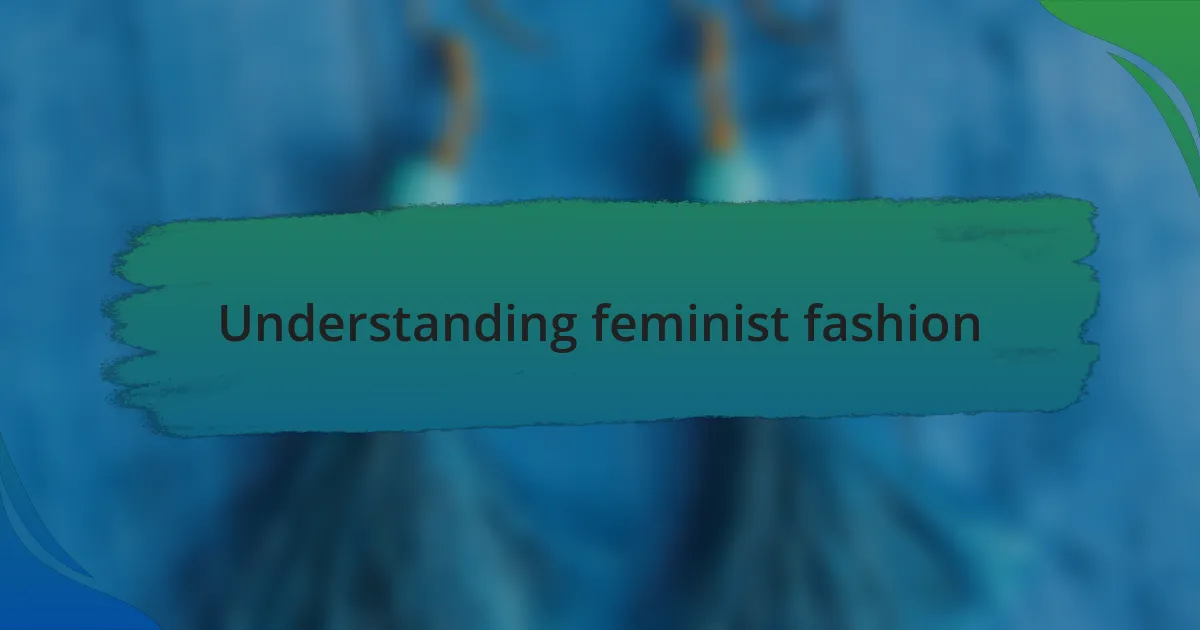
Understanding feminist fashion
Feminist fashion is not just about clothing; it’s a powerful form of self-expression that challenges societal norms. I remember the first time I wore a bold graphic tee adorned with a feminist slogan—it was empowering. It wasn’t just a piece of fabric; it was a statement that reflected my beliefs and values.
At its core, feminist fashion advocates for inclusivity and representation. Have you ever considered how the fashion industry has often sidelined diverse voices? I’ve felt this gap personally, especially when shopping for clothing that resonates with my identity. Fashion should celebrate our differences, not diminish them.
Moreover, feminist fashion encourages conversations around body positivity and sustainability. I recall an inspiring discussion I had with a friend about how ethical brands can promote not only fashionable choices but ethical principles too. Isn’t it uplifting to think that what we wear can also align with our principles and advocate for a more inclusive world?

Importance of representation in fashion
Representation in fashion is crucial because it allows all individuals to see themselves reflected in the clothing they choose to wear. I can recall browsing through a magazine and feeling a wave of pride when I spotted a model who looked like me. That moment reminded me how powerful it can be for someone to see their identity celebrated and validated through fashion.
When diverse voices are included, it fosters a sense of belonging in the fashion community. There was a time when I felt isolated because my style choices didn’t align with the mainstream trends. I find it invigorating when brands make an effort to showcase a wider array of backgrounds, body types, and cultures. It makes us all feel like we matter in this space.
Additionally, representation promotes not just visibility but also understanding. Have you ever noticed how a new collection can spark discussions about culture and identity? I’ve experienced enlightening conversations surrounding garments inspired by different heritages, leading me to appreciate the stories behind them. This connection elevates fashion from mere aesthetics to a powerful platform for dialogue and change.
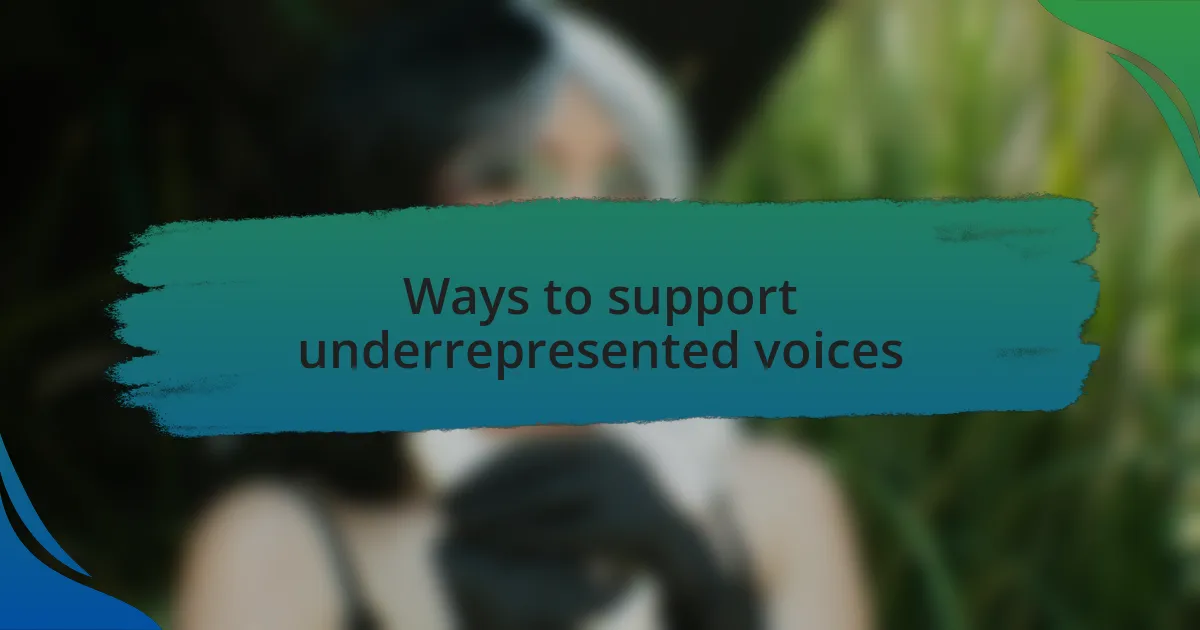
Ways to support underrepresented voices
One effective way to support underrepresented voices is to actively seek out and promote brands founded by individuals from marginalized communities. I remember the first time I discovered a small fashion label run by a woman of color; their unique designs and reflections of culture captivated me. Supporting these brands not only fuels their growth but also sends a message that diverse stories deserve to be heard in the mainstream fashion narrative.
Engagement with community-led initiatives is another powerful avenue for advocacy. I’ve participated in local fashion events that spotlight emerging designers from underrepresented groups, and the energy is electric. It’s incredible to witness firsthand the talent and creativity that flourish when given a platform, reinforcing the importance of amplifying these voices in my own circle and beyond.
Lastly, incorporating diverse perspectives into discussions—whether through articles, panels, or social media—is essential. Asking thought-provoking questions like, “How do cultural influences shape our personal style?” can open doors to deeper conversations. I strive to share my experiences while inviting others to contribute their narratives, creating a tapestry of voices that enrich our understanding of fashion’s impact.
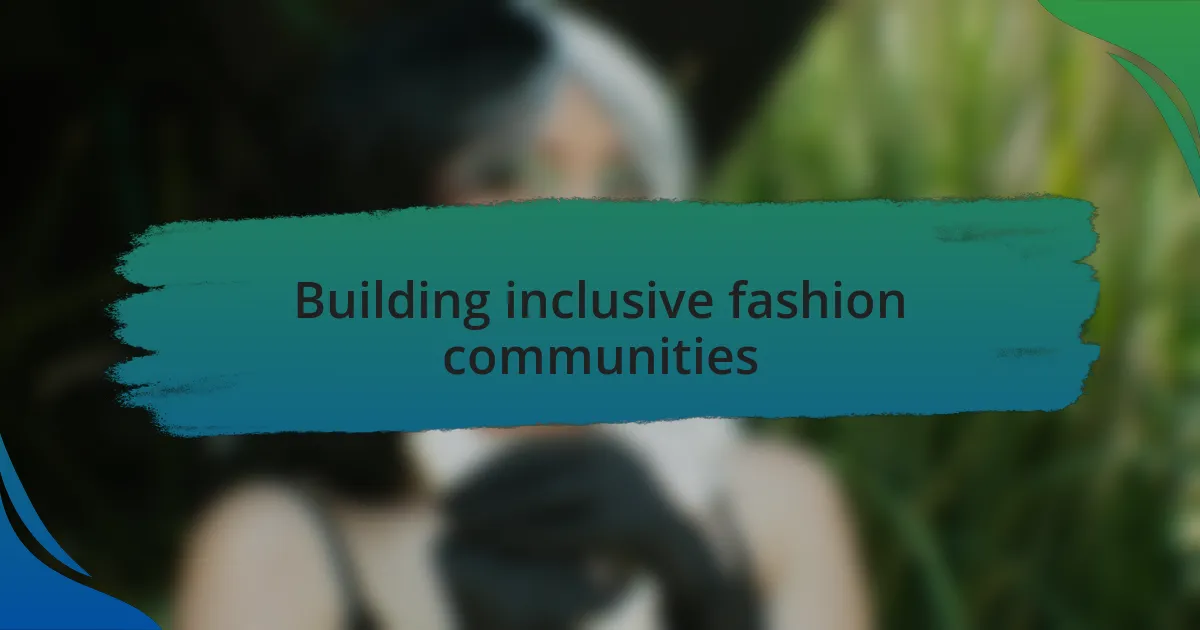
Building inclusive fashion communities
Creating inclusive fashion communities starts with intentionality in our interactions. When I joined a fashion collective that emphasized diversity, I was struck by how collaboration among different voices could spark innovative ideas. Have you ever felt the energy of a room where everyone felt their contributions mattered? That’s how I felt; it was empowering and made me realize how crucial it is to foster an environment where everyone feels welcome and valued.
Moreover, mentorship plays a pivotal role in building these communities. I’ve had the privilege of guiding younger designers from underrepresented backgrounds, sharing what I’ve learned along the way. Watching them grow and become more confident in their designs is a reminder of how uplifting it can be to extend a helping hand. It makes me think, how can we create more platforms for mentorship that champion inclusivity in fashion?
Lastly, celebrating cultural diversity through events and collaborations is essential. I recall attending a fashion showcase that honored traditional dress from various cultures, and the experience was truly eye-opening. Each piece told a story that resonated with history and identity, sparking discussions about cultural appropriation versus appreciation. How can we ensure these rich narratives are not just acknowledged but celebrated? It’s through shared experiences and an open dialogue that we can continue to build inclusive fashion communities that honor every voice.
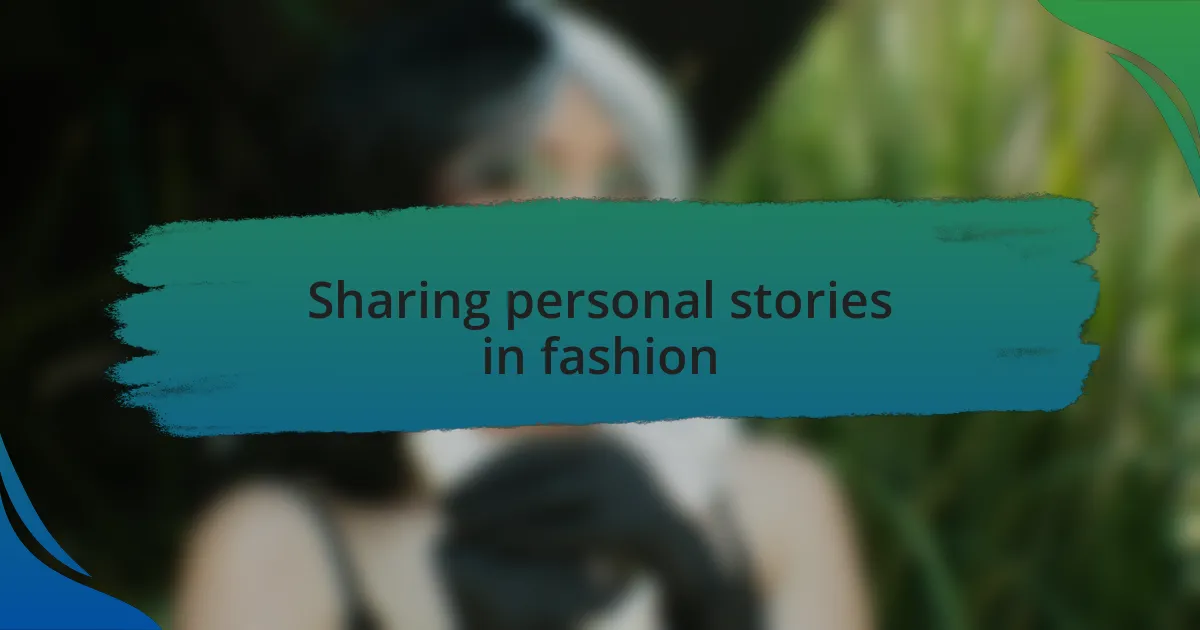
Sharing personal stories in fashion
Sharing personal stories in fashion can create profound connections that illuminate the struggles and triumphs within our communities. I remember the first time I shared my journey about facing size discrimination in the fashion industry. The vulnerability of opening up about my experience unexpectedly resonated with so many others. It made me realize how powerful it is to reflect on our individual stories; they can foster empathy and understanding in a world often focused on superficial trends.
In my experience, storytelling can also transform the way we engage with fashion. I once attended a panel discussion where several designers detailed their paths, filled with both setbacks and victories. Listening to their narratives, I felt a wave of inspiration wash over me. It made me ponder, how often do we overlook the personal stories behind the labels? Recognizing the challenges others face, along with their creative responses, can shift our perspective and deepen our appreciation for the fashion we wear.
When we share these intimate stories, we invite others to join the conversation. I often encourage fellow fashion enthusiasts to delve into their histories, reminding them of the unique angles they can bring to the table. Have you ever considered the impact your story could have on the industry? By amplifying these diverse voices, we don’t just celebrate individuality; we also pave the way for a more inclusive and compassionate fashion landscape that honors everyone’s experiences.
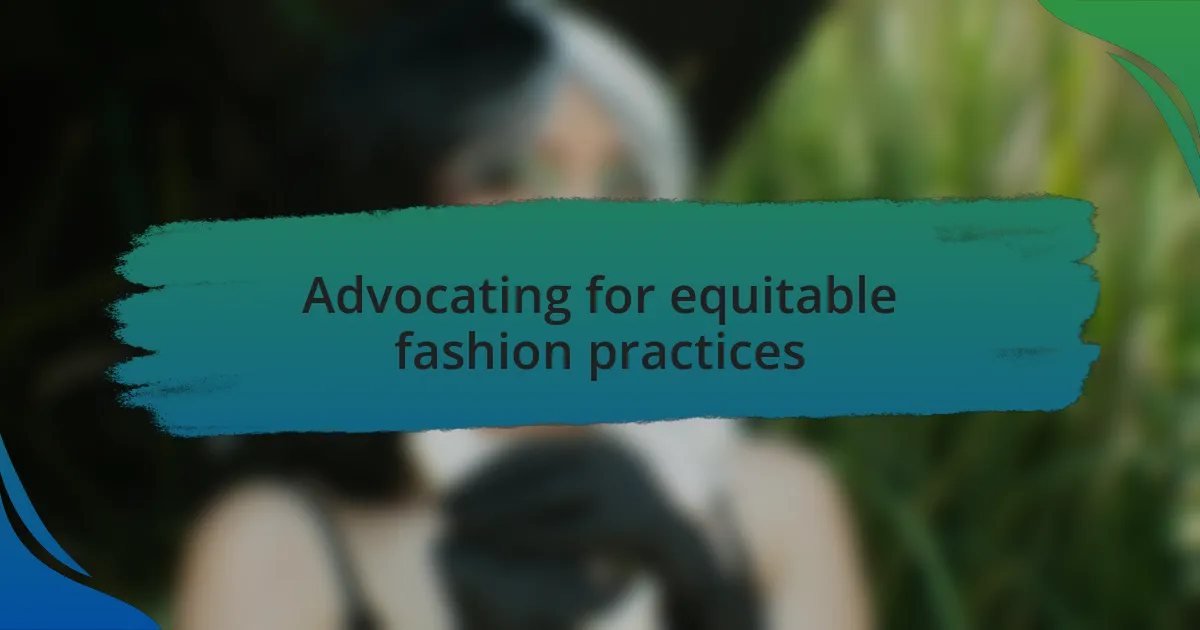
Advocating for equitable fashion practices
Advocating for equitable fashion practices means pushing for a systemic change within the industry. I recall attending a fashion show where the lineup was predominantly white and thin, a stark reminder of the exclusion that many face. It left me wondering, how can we expect genuine representation when the gatekeepers prioritize conventional beauty ideals? This experience drives me to prioritize advocating for diversity in runway shows and behind the scenes, ensuring that designers from all backgrounds get a platform to shine.
In my journey, I’ve seen firsthand how inclusive practices can reshape the narrative around fashion. Collaborating with emerging designers from marginalized communities, I’ve discovered an array of unique perspectives and innovative ideas that enrich our industry. I often ask myself, have we truly tapped into the wealth of creativity present in all corners of society? Embracing diverse voices not only cultivates richer fashion landscapes but also challenges the status quo, creating a more equitable environment for everyone involved.
Equitable fashion practices also require us to support brands that prioritize fair labor and sustainable materials. I remember the satisfaction I felt when I found a local brand that not only celebrated diverse body types but also employed artisans from underrepresented communities. It prompted me to shift my purchasing habits, questioning how every dollar spent can either uplift or hinder these voices. How can our choices create a ripple effect? By consciously choosing to support responsible brands, we can advocate for a fashion industry that uplifts all creators while standing against systemic inequities.
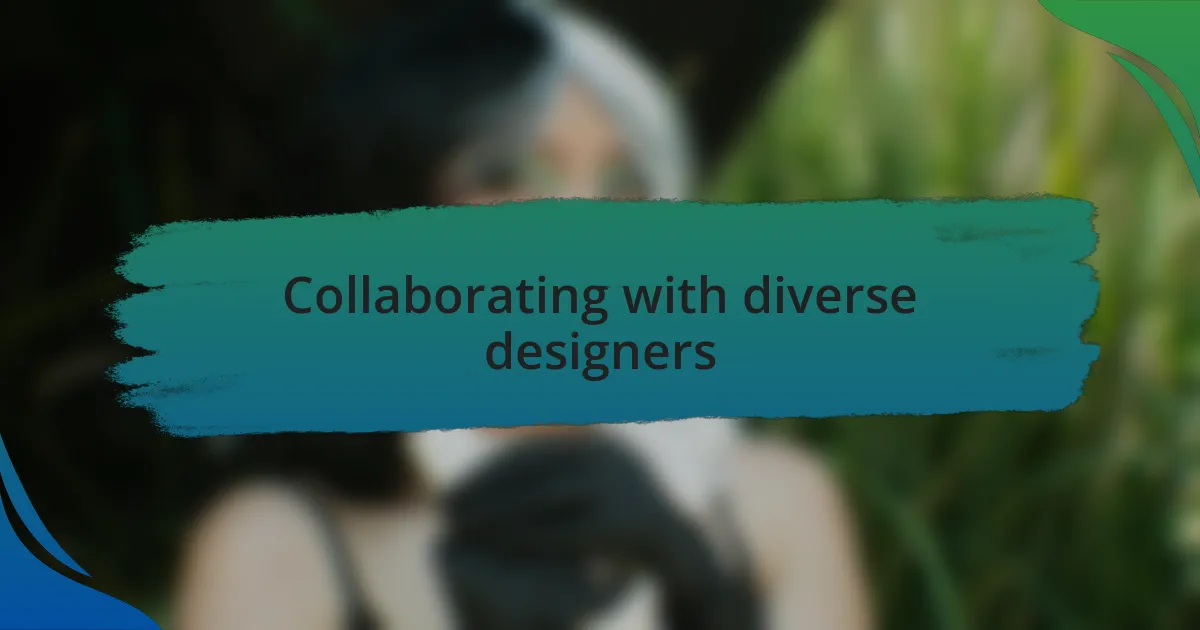
Collaborating with diverse designers
Collaborating with diverse designers has been one of the most rewarding aspects of my advocacy. I remember the excitement I felt when I teamed up with a designer from a historically marginalized background for a local fashion event. Their unique cultural designs brought a vibrancy that was sorely lacking, leading me to reflect on how much richness we lose when we don’t embrace varied perspectives in fashion.
During the process, we faced challenges that required us to address both our creative differences and the barriers set by industry norms. Yet, these very struggles led to innovative solutions and designs that truly resonated with a broader audience. It made me realize that collaboration isn’t just about aesthetics; it’s about dismantling the old narratives that have held us back. How often do we let preconceived notions dictate our collaborations? In my experience, breaking away from those limitations has allowed for fuller, more authentic expressions in fashion.
Every new partnership with a diverse designer has deepened my understanding of the profound impact that varied backgrounds can have on style and presentation. I often ask myself, what stories are we missing when we overlook these talents? Every collaboration reveals new layers of creativity that not only uplift the designer but also expand our collective horizons, pushing us toward a more inclusive and representative fashion landscape.